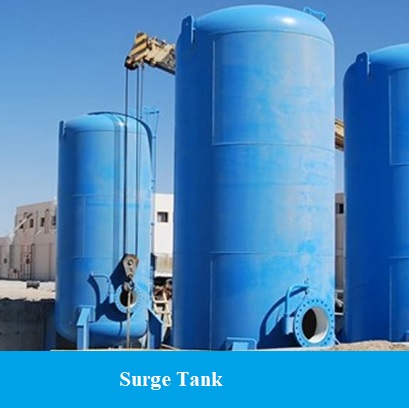A surge tank is used to store the water. It is connected with small pipes and held in a vertical position. The main function of a surge tank is to reduce the water pressure to various pipe connections. It is also known as surge drum and surge pool.

There are 3 important functions of a surge tank.
- It prevents the piping system from high internal pressure.
- The surge tank assists the hydraulic turbine regarding its regulation characteristics.
- Surge tanks store the water to increase the pressure in pressure drop conditions.
Table of Contents
Operation of Surge Tank:
Let’s consider a pipe containing flowing fluid. If the valve is partially or fully closed then fluid will continue to flow as it was before. To counteract fluid momentum, fluid pressure rises. This fluid pressure may damage the piping system. In case of surge chamber is associated with the pipeline just upstream of the valve, on valve closure, the fluid, instead of being stopped suddenly by the valve, will flow upwards into the chamber, thus reducing the surge pressures experienced in the pipeline.
When we close the wall, the liquid keeps on streaming, passing into the surge tank causing the water level in the tank to rise. The level in the tank will keep on ascending until the extra head because the height of the liquid in the tank adjusts the flood pressure in the pipeline. Now, the stream in the tank and pipeline will invert making the level in the tank drop. This swaying in the tank height and stream will proceed for quite a while however its size will disperse because of the impacts of friction.
Types of Surge Tank:
- Gallery type surge tank.
- Restricted orifice surge tank.
- Differential surge tank.
- Simple surge tank.
Let us discuss these types of surge tanks in detail.
1. Gallery Type Surge Tank
Gallery type surge tank comprises additional capacity galleries in it. These storage galleries are also known as expansion chambers. Thus, gallery-type surge tanks can likewise be known as expansion chamber-type surge tanks.
These expansion chambers are generally provided beneath and above the surge levels. Below surge level, chambers are utilized to store excess water in it and released when it is needed or there is a brief drop in pressure. Upper surge level chambers are utilized to absorb the excess pressure.

2. Restricted Orifice Surge Tank
Restricted orifice comprises an orifice between pipeline and surge tank. This orifice is also called a surge tank. in case of water overflows it should enter into the surge tank through this orifice. Due to little diameter, frictional losses will occur excess water pressure in the main pipeline is destroyed.

3. Differential Surge Tank
If there should be an occurrence of a surge tank, an interior riser is fixed in the tank. This riser has little distance across through which water goes into the riser when it overflows. The riser likewise contains annular ports at its lower end.

4. Simple Surge Tank
A simple surge tank resembles a vertical pipe that is associated with middle penstock and turbine generator. These are built with greater height and supports are also given to hold the tank. When the water flow is randomly increased the water is collected in the surge tank and neutralizes the pressure.

Frequently Asked Questions:
What is Surge Chamber?
A surge chamber is a big pressurized underground chamber creating a free surface in the waterway to boost the dynamic abilities of the power plant waterways. A surge chamber is used for long waterways when a shaft can not be created to fulfill the same purpose.
